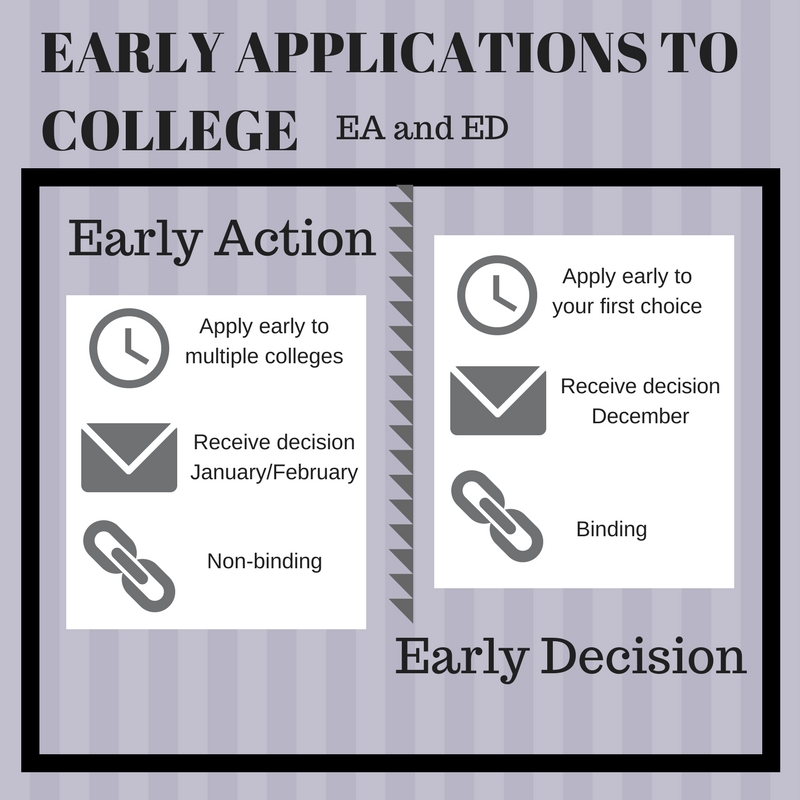Early Action vs Early Decision
Graphic by Hayley Beluch ’18
Let’s start with the basics.
Early decision is binding, which means you are fully committing to a school no matter what. Early action simply means your application was ready early and you wanted to get it in and out of the way.
That’s the simple explanation, but much like everything in life, it’s slightly more intricate.
When applying to any school, it is important to keep in mind how high that school is ranked on your list of schools you want to apply to and hopefully attend.
For Early Decision, you apply to one school and if you get in, you are committed to them no matter what. It doesn’t matter the financial situation and you cannot apply Early Decision to any other schools.
“For example, if a student applying to the University of Penn doesn’t get in early decision, then the next day, we send out all of their other applications,” said Ms. Lattimer, a guidance counselor.
Early Action has less stipulations.
“If a student is ready to have their application completed in an early timeframe, if I am not rushing them, I am certainly going to encourage a student to apply early action,” said Ms. Lattimer.
This is because it cannot hurt a student; it will just help them get their application in early and get an answer back sooner.
This also alleviates the waiting game in February and March. If all goes well, the student could hear back as early as January 1st. It also helps if something winds up missing—I know that sounds crazy!
However, colleges sometimes misplace transcripts and a student may have to re- send that information to the school. If the student applied Early Action, then it allows for more time to x any problem that may have surfaced during the application process.
“I don’t think there is any negative,” said Ms. Lattimer. If the school is still uncertain, they will defer you until the regular admissions pool and again, there is no harm there.
“Most, if not all of my students, have applied early action or decision,” said Mrs. Palmer, the GT teacher.
It all comes down to if there is one particular school that a student really wants to get into regardless of financial aid. The school and the program they want is a ten in their eyes. If this is the case, then early decision is the way to go.
Early Action is becoming more common for students, because schools are giving out money earlier and students are getting better financial deals through Early Action. Schools will only offer one or the other.
They will not offer Early Decision and Early Action. Many Ivy League colleges are Early Decision because they don’t necessarily want you applying to any other schools. You can apply Early Decision to one school and Early Action to other schools or apply ED to one school and wait for regular admissions.
“Money can be a factor in terms of what is available for scholarship money and students wanting to get the possible best deal,” said Palmer.
Nowadays, students are taking advantage of Early Decision and Early Action to get the best deal, because the FAFSA form deadline is now October 1st which is a lot earlier compared to January 1st. You also needed to have your tax returns done.
Now, students can file the FAFSA, so that is done and applications can be ready earlier.
“I would love to see for Eastern to put some resources into having guidance counselors available in August for seniors. This way, they can get a jumpstart of the application process,” said Palmer. Having access to your guidance as early as August will only be beneficial for students.
“It could be paired with the essay classes that the school offers,” Palmer said. “It forces students to get on the ball with their applications.”
“Allowing seniors to have special pre-access to counselors while they are wrapping up testing and applications, I think, is crucial to the success or eastern students and a welcomed change,” said Palmer.
Even the world of standardized testing is adapting to the ED and EA deadlines because, they are offering tests in the summer to accommodate.
This process is not for everyone; it is not reserved for the top five percent of your class either. It is for kids who know what they want to do and where they want to be. They have taken early steps to identify school and put their best foot forward.
“Every year I get more and more,” said Mrs. Lattimer.
If you look at acceptance rate trends for Ivy League schools, the ED pool is greater than the regular admissions pool. It will increase your chance because you are sending a very clear message that you are really interested in what that school has to offer.
You are not sending things in early just for fun and you do not want to jump the gun. It is only if you are ready to send everything in. When applying EA, you can turn down the school, but only in the most extreme cases can you turn down a school that you applied ED for. It is not a accept or decline situation on a ED application.
“I applied EA, but not ED. I applied EA to mostly state schools, because I wasn’t looking for anything binding,” said Diana Bershadsky ‘18.
“I also applied EA to every school that offered it. It’s really nice hearing back early,” said Kryssie Vujic ‘18.
From students, to teachers, to guidance counselors, it is a universal view that EA and ED depend on the individual student, but neither one can harm you. It’s all about who you are as student.











